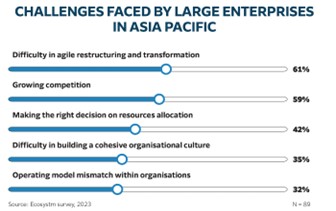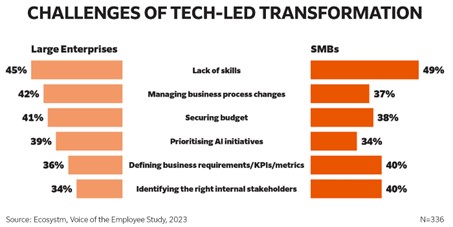Successful Digital Transformation is Key to Driving Innovation

Astragraphia Document Solution - Are you innovating for the sake of innovation or innovating to help solve real problems - growing the enterprise and staying ahead of the competition? Planning is essential for successful change and innovation, and a well-executed Digital Transformation (DX) plan can enable it all.
In today's fast-paced world, big companies often require greater agility in their technology-driven transformations. However, navigating through bureaucratic red tape and multiple rounds of approval for new technology adoption can make it challenging for them to stay competitive. 61% of large enterprises in the APAC region struggle with agility when it comes to restructuring and transformation, which they identify as their greatest obstacle to success.

Even though enterprises are often considered innovative and tech-savvy, many still rely on outdated manual processes and fragmented backend operations with data silos. They underutilize digital technologies and are slow to adapt to the modern enterprise environment.

In addition, the lack of digital skills is a harsh reality, blocking large organizations from transforming. Start small with quick wins like digitization to build a sustainable foundation for your DX project. You can also tap on the expertise of a technology partner to assess your existing tech suite to better understand how to streamline your business processes.
The heart of innovation is a simple, well-executed DX plan.
How to innovate successfully? Make people the focus of your DX strategy - creating an environment where innovation can thrive, e.g. optimizing business processes through automation. Solutions like moving to the cloud, business process automation, and managed IT services can free up employees' time to focus on meaningful work like creating new ideas that can advance businesses. And this doesn't necessarily require a complete overhaul of existing infrastructure.
By identifying gaps in your current infrastructure and tech stack, your team will be able to start building meaningful solutions. This is a critical aspect of your digital transformation journey and an essential part of the resilience agenda, which prioritizes innovating for people
3 steps to a simple, well-executed digital transformation plan:
- Identify key areas for digitization: Start by identifying the areas in your workflows and processes that can be digitised. For example, it could be in automating manual processes, improving communication channels, or enhancing the customer experience.
- Develop a roadmap: Once you have identified the areas for digitization, create a roadmap that outlines the steps you need to take to achieve your goals. This could involve implementing new software, upgrading existing systems, or hiring new talent. Make sure to set realistic timelines and milestones to track progress
- Foster a culture of innovation: Empower your team to experiment with new technologies and provide the necessary resources and support, such as training, innovation labs, or external partnerships. This encourages open collaboration and feedback, ensuring bottom-up suggestions in identifying areas for improvement are heard and valued.
True transformation starts with a vision.
But true transformation can only begin from the top. Business leaders need to set a vision for change and direction for the business’s long-term goals while leaving room for teams to decide the best way to achieve a solution. One way could be by listening to ground sentiments. This allows leaders to identify potential areas for improvement and work collaboratively with employees to create and implement new ideas.
Allowing employees to adjust their execution and provide input into the transformation helps them feel part of the change, and lets them support the initiative with their energy and ideas. A simple, well-executed digital transformation plan will allow teams the flexibility to act on this vision and turn it into reality.
The heart of innovation is people.
It's not only about embracing novel technologies; it's also about how these technologies can empower new human behaviors and experiences. This is an important aspect of your digital transformation journey as it creates a process to fill your enterprise gaps with meaningful solutions, centered around the principle of innovating for people.




